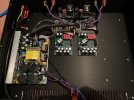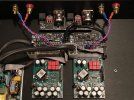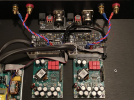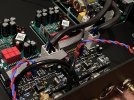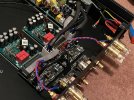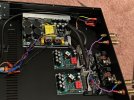AES 48 is not considered as an opinionWhose wrong/recommended practice is that? When you look around there seems to be significant difference of opinion.
I also suspect that which works better will depend significantly on the specifics of equipment grounding design.
-
WANTED: Happy members who like to discuss audio and other topics related to our interest. Desire to learn and share knowledge of science required. There are many reviews of audio hardware and expert members to help answer your questions. Click here to have your audio equipment measured for free!
You are using an out of date browser. It may not display this or other websites correctly.
You should upgrade or use an alternative browser.
You should upgrade or use an alternative browser.
Noisy Purifi amplifiers
- Thread starter vco1
- Start date
Chester
Senior Member
- Joined
- May 22, 2021
- Messages
- 443
- Likes
- 1,069
Since investigating further, the left channel of my Purifi has more hiss than the right. Neither is terrible but am interested in seeing if there’s anything I can do to remove it. Source is an RME ADI-2 Pro and speakers are Revel F208’s. Here’s a pic inside the amp, it’s a Nord. Can anyone spot anything inside that looks like a potential cause of this?
Again, appreciate this is just hair splitting differences, I’m a recovering audiophile though so the urge to tinker is still strong
Thanks
Again, appreciate this is just hair splitting differences, I’m a recovering audiophile though so the urge to tinker is still strong
Thanks
Attachments
I admit to being unfamiliar with the standard - is it mandatory? Will compliant cabling always give the best result even if equipment grounding is not compliant?AES 48 is not considered as an opinion.
Id say the most likely cause is coupling from the power supply to the left hand module (is that the one with higher noise?).Since investigating further, the left channel of my Purifi has more hiss than the right. Neither is terrible but am interested in seeing if there’s anything I can do to remove it. Source is an RME ADI-2 Pro and speakers are Revel F208’s. Here’s a pic inside the amp, it’s a Nord. Can anyone spot anything inside that looks like a potential cause of this?
Again, appreciate this is just hair splitting differences, I’m a recovering audiophile though so the urge to tinker is still strong
Thanks
Possibly from that ribbon cable routed pretty much in contact with the module. If that is the noisier module I'd start with trying to space the ribbon cable as far from the module as possible. Then the thick black power lead.
After that, I might have to start gettting inelligent and working out what the cables carry - and what circuit elements they are in proximity to. (depending on this routing the ribbon cable closer to the power lead might make things worse)
JSmith
Master Contributor
Chester
Senior Member
- Joined
- May 22, 2021
- Messages
- 443
- Likes
- 1,069
Id say the most likely cause is coupling from the power supply to the left hand module (is that the one with higher noise?).
Possibly from that ribbon cable routed pretty much in contact with the module. If that is the noisier module I'd start with trying to space the ribbon cable as far from the module as possible. Then the thick black power lead.
Thank you, yes that’s right, it is the left channel that is noisier.
Truth be told most rooms' noise floor would drown any tweeter hiss when you're using a 120 db S/N chain. Unless you mean in anechoic condition but that's a hyperbole on its own.Purifi specify 11.5uV A-WTD.
No power amplifier is 'dead silent', especially when in close proximity to tweeters.
If i remember correctly the 11.5uV specification is only possible with academic grade power supplies according to @boXem | audio
Last edited:
It is not mandatory in terms of "required by law'. It specifies how balanced connections should be done to avoid problems. Pro world follows it. On the non-pro side, there are more artists for whom following a standard is a limitation to their artI admit to being unfamiliar with the standard - is it mandatory? Will compliant cabling always give the best result even if equipment grounding is not compliant?
restorer-john
Grand Contributor
Truth be told most rooms' noise floor would drown any tweeter hiss when you're using a 120 db S/N chain. Unless you mean in anechoic condition but that's a hyperbole on its own.
If i remember correctly the 11.5uV specification is only possible with academic grade power supplies according to @boXem | audio
Don't confuse S/N with audibility of residual noise. The more 'signal' you have, the greater you can lift that signal above the noise. Wind up the voltage swing (power) and even an average to poor residual noise gets an elevated S/N number for 'free'.
My power amplifiers have a 120dB S/N and I can hear residual in the tweeters from a foot away at zero volume in a dead silent room. The residual is less than 35uV (A).
And the gain at which the amplifier is set results in how much maximum output? because if it's set to 100 dBSPL at maximum input then the noise floor should be around -20dBSPL which should theoretically be inaudible. in normal room conditions where the noise floor could be anywhere from 10 to 40 dBSPL even at high frequencies.My power amplifiers have a 120dB S/N and I can hear residual in the tweeters from a foot away at zero volume in a dead silent room. The residual is less than 35uV (A).
With "dead silent" I mean that both 11,5uV and 20uV will be impossible to hear even with the ear very close to a standard dome tweeter.Purifi specify 11.5uV A-WTD.
No power amplifier is 'dead silent', especially when in close proximity to tweeters.
Our purifibased amplifiers Vera P150/600 has a noise floor of 18uV measured on the speaker terminals. On my 92dB/W speakers it is below my hearing threshold even with my ear 10mm from the tweeter. That is how silent these modules are. I had to borrow a monster 7 kilo compression driver with a sensitivity of 108dB/W to be able to hear a faint hiss with my ear very close.
When people have noise problems it is in almost all cases caused by the source. Note also that simply removing the input will increase the amplifier noise. The only way to proper evaluate amplifier noise, is to short or terminate the inputs with 100 Ohm
Thanks.It is not mandatory in terms of "required by law'. It specifies how balanced connections should be done to avoid problems. Pro world follows it. On the non-pro side, there are more artists for whom following a standard is a limitation to their art.
Chester
Senior Member
- Joined
- May 22, 2021
- Messages
- 443
- Likes
- 1,069
With "dead silent" I mean that both 11,5uV and 20uV will be impossible to hear even with the ear very close to a standard dome tweeter.
Our purifibased amplifiers Vera P150/600 has a noise floor of 18uV measured on the speaker terminals. On my 92dB/W speakers it is below my hearing threshold even with my ear 10mm from the tweeter. That is how silent these modules are. I had to borrow a monster 7 kilo compression driver with a sensitivity of 108dB/W to be able to hear a faint hiss with my ear very close.
When people have noise problems it is in almost all cases caused by the source. Note also that simply removing the input will increase the amplifier noise. The only way to proper evaluate amplifier noise, is to short or terminate the inputs with 100 Ohm
I quite fancy trying your XLR shorting method you mentioned earlier in this thread, to see what noise is then audible, but as a total novice in this area, sticking wire into two holes and turning it on just feels like it will end in tears.
- Joined
- Aug 14, 2018
- Messages
- 2,769
- Likes
- 8,145
My speakers are medium efficiency (87 db/2.83V/1m), and I cannot hear any sound whatever from them with the Purifi hooked up, even with my ear close up to the tweeter.
Same - my speakers are rated at 89dB efficiency and I can't hear anything at all with my Audiophonics Purifi-based amp. ear right at the tweeter.
I did hear a very low-level hiss when I had a ground loop in my system, though, and the removal of all hiss from the amp with the ground loop solved did surprise me, since I always thought the ground loop would only produce 50/60Hz hum (and perhaps low-order harmonics thereof).
I suspect some, perhaps a lot, of the variability in hearing or not hearing hiss could be the presence or absence of ground loops in the system, particularly since the other components do not actually have to be turned on (just plugged in to AC) in order for the effect to happen.
It's safeI quite fancy trying your XLR shorting method you mentioned earlier in this thread, to see what noise is then audible, but as a total novice in this area, sticking wire into two holes and turning it on just feels like it will end in tears.
JaapDeventer
Member
- Joined
- Oct 29, 2018
- Messages
- 31
- Likes
- 34
I had a hiss with my first DIY AES EBU cables. A different cable with more shielding did much better. Strangely a pair of rca converters and rca cable was dead silent.
Since investigating further, the left channel of my Purifi has more hiss than the right. Neither is terrible but am interested in seeing if there’s anything I can do to remove it. Source is an RME ADI-2 Pro and speakers are Revel F208’s. Here’s a pic inside the amp, it’s a Nord. Can anyone spot anything inside that looks like a potential cause of this?
Again, appreciate this is just hair splitting differences, I’m a recovering audiophile though so the urge to tinker is still strong
Thanks
Is it perhaps the channel closer to the power supply?
Happy for you that noise is gone away, still I am now very skeptical about Audiophonics implementation....after opening the amp that feeling turned out to be right. It was set to "Configuration 2" for approx. 2.25V RMS. So I removed the gain jumper to get to the 4.2V RMS configuration. And gone was all the noise. Like magic.
...
Why should the 2.25V configuration be noisy?
It is not to be justified according to me
Because the gain is doubled, and hence any noise (internal from the amp, or coming from the source) is also doubled.
Similar threads
- Replies
- 478
- Views
- 16K
- Replies
- 10
- Views
- 502
- Replies
- 6
- Views
- 1K
- Replies
- 99
- Views
- 6K

